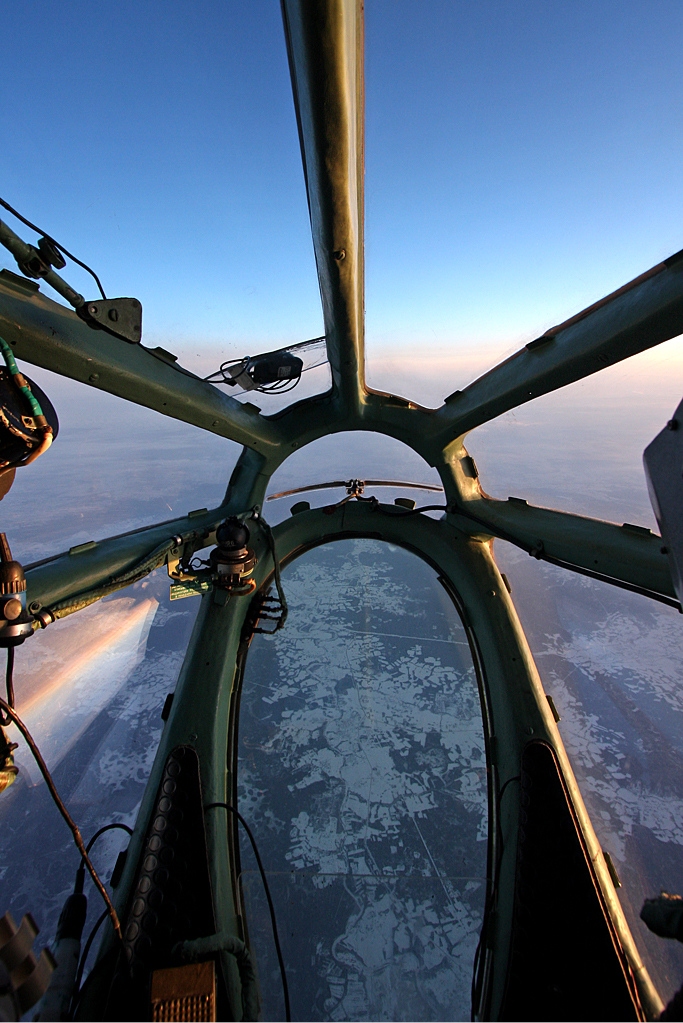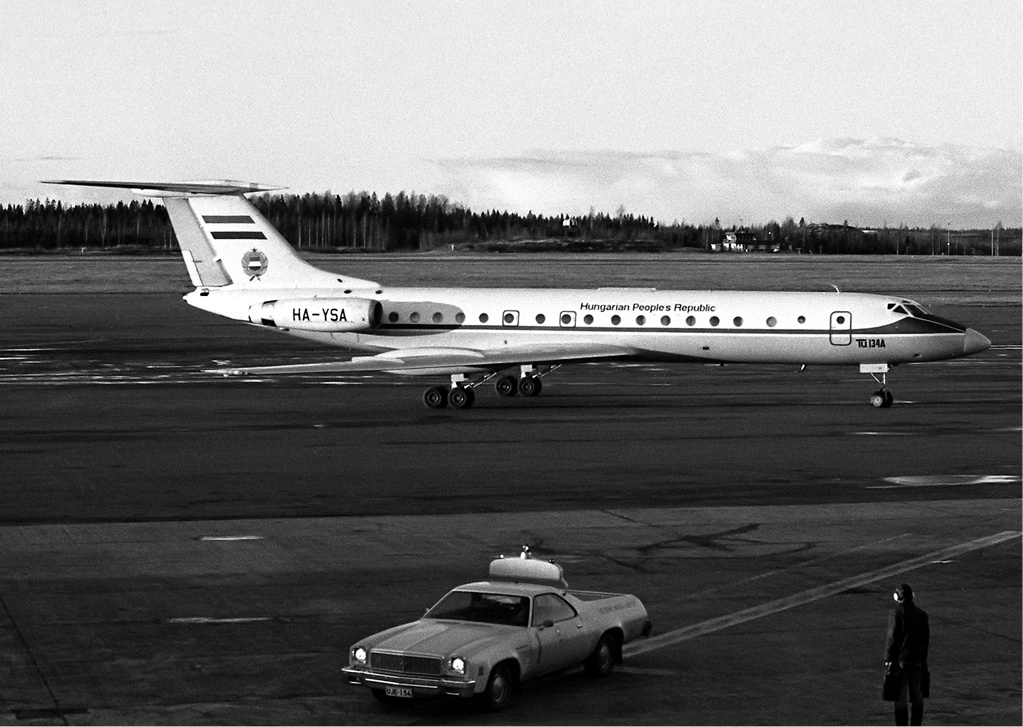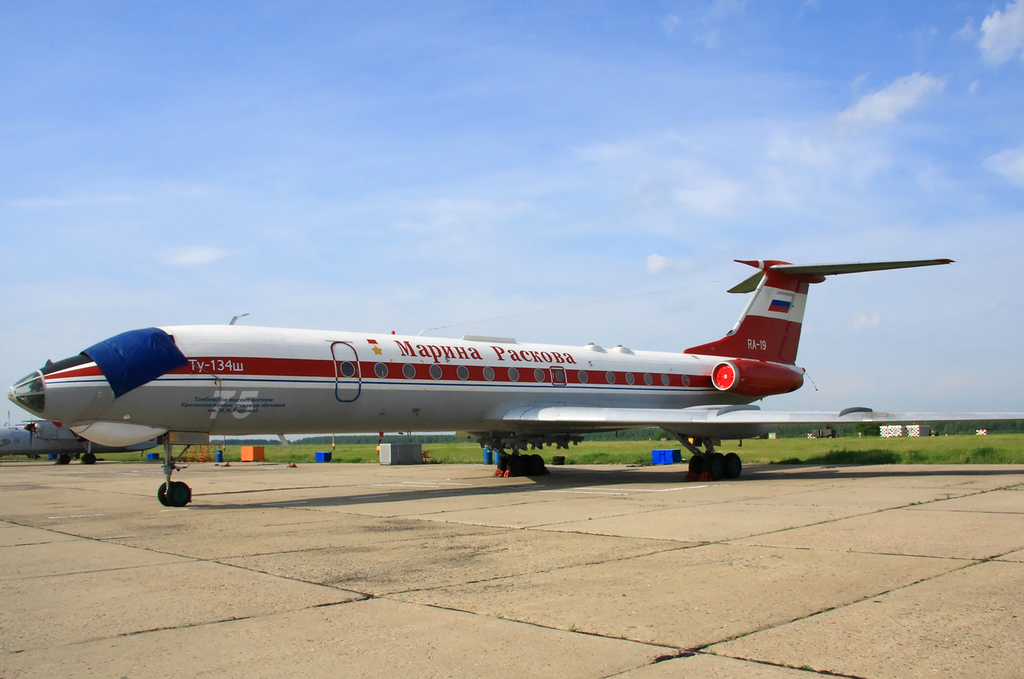Tupolev Tu-134B on:
[Wikipedia]
[Google]
[Amazon]
The Tupolev Tu-134 (
 Following the introduction of engines mounted on pylons on the rear fuselage by the French
Following the introduction of engines mounted on pylons on the rear fuselage by the French  During a 1960 visit to France, Soviet leader Nikita Khrushchev was so impressed by the quiet cabin of the Caravelle, that on 1 August 1960 the Tupolev OKB received an official directive to create the Tu-124A with a similar engine arrangement. The requirement was also driven by the need to replace slow, aging piston-engined Il-14s on domestic routes. In 1961, the Soviet state airline,
During a 1960 visit to France, Soviet leader Nikita Khrushchev was so impressed by the quiet cabin of the Caravelle, that on 1 August 1960 the Tupolev OKB received an official directive to create the Tu-124A with a similar engine arrangement. The requirement was also driven by the need to replace slow, aging piston-engined Il-14s on domestic routes. In 1961, the Soviet state airline,

 ;Tu-134A
:Second series, with upgraded engines, improved avionics, seating up to 84 passengers. All Tu-134A variants have been built with the distinctive glass nose and chin radar dome, but some were modified to the B standard with the radar moved to the nose radome.
;Tu-134A-2
:The glass nose was replaced.
;Tu-134A-3
:Second series, powered by two updated Soloviev D-30 turbofan engines.
;Tu-134A-5
:Most recent version.
;Tu-134B
:Second series, 80 seats, radar moved to the nose radome, eliminating the glazed nose. Some Tu-134B models have long-range fuel tanks fitted under the fuselage; these are visible as a sizable bulge.
;Tu-134BV
:Space shuttle work model.
;Tu-134LK
: Cosmonaut training version.
;Tu-134A
:Second series, with upgraded engines, improved avionics, seating up to 84 passengers. All Tu-134A variants have been built with the distinctive glass nose and chin radar dome, but some were modified to the B standard with the radar moved to the nose radome.
;Tu-134A-2
:The glass nose was replaced.
;Tu-134A-3
:Second series, powered by two updated Soloviev D-30 turbofan engines.
;Tu-134A-5
:Most recent version.
;Tu-134B
:Second series, 80 seats, radar moved to the nose radome, eliminating the glazed nose. Some Tu-134B models have long-range fuel tanks fitted under the fuselage; these are visible as a sizable bulge.
;Tu-134BV
:Space shuttle work model.
;Tu-134LK
: Cosmonaut training version.
 ;Tu-134M
:Projected modernized version of Tu-134B, powered by Progress D-436T1-134 engines.
;Tu-134S
:Projected cargo version based on Tu-134A.
;Tu-134UBL
: Tu-160 crew training version, with Tu-160 nose cone.
;Tu-134UBK
:Naval version of Tu-134UBL. Only one was ever built.
;Tu-134BSh
:Tu-22M crew trainer, fitted with a Tu-22M radar in the nose.
;Tu-134Sh-1
:Crew trainer with bomb racks for heavy bomber crews
;Tu-134Sh-2
:navigator trainer for tactical bomber crews
;Tu-134SKh
:Crop survey version.
;Tu-134M
:Projected modernized version of Tu-134B, powered by Progress D-436T1-134 engines.
;Tu-134S
:Projected cargo version based on Tu-134A.
;Tu-134UBL
: Tu-160 crew training version, with Tu-160 nose cone.
;Tu-134UBK
:Naval version of Tu-134UBL. Only one was ever built.
;Tu-134BSh
:Tu-22M crew trainer, fitted with a Tu-22M radar in the nose.
;Tu-134Sh-1
:Crew trainer with bomb racks for heavy bomber crews
;Tu-134Sh-2
:navigator trainer for tactical bomber crews
;Tu-134SKh
:Crop survey version.



NATO reporting name
NATO reporting names are code names for military equipment from Russia, China, and historically, the Eastern Bloc (Soviet Union and other nations of the Warsaw Pact). They provide unambiguous and easily understood English words in a uniform manne ...
: Crusty) is a twin-engined, narrow-body jet airliner built in the Soviet Union for short and medium-haul routes from 1966 to 1989. The original version featured a glazed-nose design and, like certain other Russian airliners (including its sister model the Tu-154), it can operate from unpaved airfields.
One of the most widely used aircraft in former Comecon countries, the number in active service is decreasing because of operational safety concerns and noise restrictions. The model has seen long-term service with some 42 countries, with some European airlines having scheduled as many as 12 daily takeoffs and landings per plane. In addition to regular passenger service, it has also been used in various air force, army and navy support roles; for pilot and navigator training; and for aviation research and test projects. In recent years, a number of Tu-134s have been converted for use as VIP transports and business jets. A total of 854 Tu-134s were built of all versions (including test bed examples) with Aeroflot
PJSC AeroflotRussian Airlines (russian: ПАО "Аэрофло́т — Росси́йские авиали́нии", ), commonly known as Aeroflot ( or ; russian: Аэрофлот, , ), is the flag carrier and the largest airline of Russia. The ...
as the largest user; by 1995, the Tu-134 had carried 360 million passengers for that airline.
Design and development
 Following the introduction of engines mounted on pylons on the rear fuselage by the French
Following the introduction of engines mounted on pylons on the rear fuselage by the French Sud Aviation Caravelle
The Sud Aviation SE 210 Caravelle is a French jet airliner produced by Sud Aviation.
It was developed by SNCASE in the early 1950s and made its maiden flight on 27 May 1955.
It included some de Havilland designs and components developed for t ...
, airliner manufacturers around the world rushed to adopt the new layout. Its advantages included clean wing airflow without disruption by nacelles or pylons and decreased cabin noise. At the same time, placing heavy engines that far back created challenges with the location of the centre of gravity in relation to the centre of lift, which was at the wings. To make room for the engines, the tailplanes had to be relocated to the tail fin, which had to be stronger and therefore heavier, further compounding the tail-heavy arrangement.
 During a 1960 visit to France, Soviet leader Nikita Khrushchev was so impressed by the quiet cabin of the Caravelle, that on 1 August 1960 the Tupolev OKB received an official directive to create the Tu-124A with a similar engine arrangement. The requirement was also driven by the need to replace slow, aging piston-engined Il-14s on domestic routes. In 1961, the Soviet state airline,
During a 1960 visit to France, Soviet leader Nikita Khrushchev was so impressed by the quiet cabin of the Caravelle, that on 1 August 1960 the Tupolev OKB received an official directive to create the Tu-124A with a similar engine arrangement. The requirement was also driven by the need to replace slow, aging piston-engined Il-14s on domestic routes. In 1961, the Soviet state airline, Aeroflot
PJSC AeroflotRussian Airlines (russian: ПАО "Аэрофло́т — Росси́йские авиали́нии", ), commonly known as Aeroflot ( or ; russian: Аэрофлот, , ), is the flag carrier and the largest airline of Russia. The ...
, updated its requirement specifications to include greater payload and passenger capacity.
The first Tu-124A prototype, SSSR-45075, first flew on 29 July 1963. On 22 October 1963, the prototype British BAC One-Eleven
The BAC One-Eleven (or BAC-111/BAC 1-11) was an early jet airliner produced by the British Aircraft Corporation (BAC).
Originally conceived by Hunting Aircraft as a 30-seat jet, before its merger into BAC in 1960, it was launched as an 80-se ...
, which had a similar layout, crashed with the loss of all crew while testing its stalling properties. The aircraft had entered pitch-up: the high-mounted tailplane became trapped in the turbulent wake produced by the wings (deep stall
In fluid dynamics, a stall is a reduction in the lift coefficient generated by a foil as angle of attack increases.Crane, Dale: ''Dictionary of Aeronautical Terms, third edition'', p. 486. Aviation Supplies & Academics, 1997. This occurs when t ...
), which prevented recovery from the stall. As a result, the tailplane on Tu-124A was enlarged by 30% for greater control authority. Since Aeroflot's requirements dictated a larger aircraft than initially planned, the Soloviev Design Bureau developed the more powerful D-30 low-bypass turbofan engines. On 20 November 1963, the new airliner was designated Tu-134.
Design curiosities of the Tu-134 included a sharp wing sweepback of 35 degrees, compared to 25–28 degrees in its counterparts. The engines on early production Tu-134s lacked thrust reversers, which made the aircraft one of the few airliners to use a brake parachute
A drogue parachute is a parachute designed for deployment from a rapidly-moving object. It can be used for various purposes, such as to decrease speed, to provide control and stability, or as a pilot parachute to deploy a larger parachute. V ...
for landing. The majority of onboard electronics operated on direct current. The lineage of early Soviet airliners could be traced directly to the Tupolev Tu-16 strategic bomber, and the Tu-134 carried over the glass nose for the navigator and the landing gear fitted with low-pressure tires to permit operation from unpaved airfields.
Serial production began in 1966 at the Kharkov Aviation Production Association, and production of the Tu-124
The Tupolev Tu-124 (NATO reporting name: Cookpot) was a 56-passenger short-range twinjet airliner built in the Soviet Union. It was the first Soviet airliner powered by turbofan engines.
Design and development
Developed from the medium-range ...
was discontinued. The Tu-134 was designed for short-haul lines with low passenger traffic. Originally the aircraft had 56 seats in a single class configuration, or 50 seats in a two-class configuration.
In 1968, Tupolev began work on an improved Tu-134 variant with a 72-seat capacity. The fuselage received a plug for greater passenger capacity and an auxiliary power unit in the tail. As a result, the maximum range was reduced from 3,100 kilometers to 2,770 kilometers. The upgraded D-30 engines now featured thrust reversers, replacing the parachute. The first Tu-134A, converted from a production Tu-134, flew on 22 April 1969. The first airline flight was on 9 November 1970. An upgraded version, the Tu-134B began production in 1980, with the navigator position abandoned, and seating capacity increased to 96 seats. Efforts subsequently began to develop a Tu-134D with increased engine thrust, but the project was cancelled.
Operational history
In September 1967, the Tu-134 made its first scheduled flight from Moscow toAdler
Adler may refer to:
Places
*Adler, Alabama, an unincorporated community in Perry County
*Adler Planetarium, Chicago, Illinois, USA
*Adler Township, Nelson County, North Dakota, USA
*Adler University, formerly Adler School of Professional Psycholo ...
. The Tu-134 was the first Soviet airliner to receive international certification from the International Civil Aviation Organization, which permitted it to be used on international routes. Due to this certification, Aeroflot used most of its Tu-134s on international routes. In 1968, the first export customers, Interflug of East Germany, LOT Polish Airlines
LOT Polish Airlines, legally incorporated as Polskie Linie Lotnicze LOT S.A. (, ''flight''), is the flag carrier of Poland. Established in 1928, LOT was a founding member of IATA and remains one of the world's oldest airlines in operation. Wit ...
and Malév Hungarian Airlines
MALÉV Ltd. ( hu, Malév Zrt.), which did business as MALÉV Hungarian Airlines ( hu, Magyar Légiközlekedési Vállalat, abbreviated ''MALÉV'', ), was the flag carrier of Hungary from 1946 until 2012. Its head office was in Budapest, wit ...
purchased the Tu-134. In 1969, the Tu-134 was displayed at the Paris Air Show.
From 1972, Aeroflot began placing the Tu-134 in domestic service to Baku
Baku (, ; az, Bakı ) is the capital and largest city of Azerbaijan, as well as the largest city on the Caspian Sea and of the Caucasus region. Baku is located below sea level, which makes it the lowest lying national capital in the world a ...
, Yerevan, Kyiv, Kishinev, Krasnodar, Leningrad, Omsk
Omsk (; rus, Омск, p=omsk) is the administrative center and largest city of Omsk Oblast, Russia. It is situated in southwestern Siberia, and has a population of over 1.1 million. Omsk is the third largest city in Siberia after Novosibirsk ...
, Riga
Riga (; lv, Rīga , liv, Rīgõ) is the capital and largest city of Latvia and is home to 605,802 inhabitants which is a third of Latvia's population. The city lies on the Gulf of Riga at the mouth of the Daugava river where it meets the Ba ...
, and Sochi
Sochi ( rus, Со́чи, p=ˈsotɕɪ, a=Ru-Сочи.ogg) is the largest resort city in Russia. The city is situated on the Sochi River, along the Black Sea in Southern Russia, with a population of 466,078 residents, up to 600,000 residents in ...
from Sheremetyevo International Airport in Moscow.
In its early years, the Tu-134 developed a reputation for reliability and efficiency, especially when compared with previous Soviet designs. After the establishment of tougher noise standards in the ICAO regulations in 2002, the Tu-134 was banned from most western European airports for its high noise levels. In early 2006, 245 Tu-134s were still in operation, 162 of which were in Russia. After a fatal accident in March 2007, and at the instigation of Russian Minister of Transportation Igor Levitin, Aeroflot announced that it would be retiring its fleet, and the last Tu-134 was removed from service on 1 January 2008. Some were still in operations with Aeroflot subsidiaries on local routes within Russia. The Tu-134 also found a new life as a business jet with many having an expensive business interior installed. High fuel and maintenance costs are increasingly limiting the number used today.
In June 2011, as a response to RusAir Flight 9605 which resulted in 47 fatalities, Russian president Dmitry Medvedev
Dmitry Anatolyevich Medvedev ( rus, links=no, Дмитрий Анатольевич Медведев, p=ˈdmʲitrʲɪj ɐnɐˈtolʲjɪvʲɪtɕ mʲɪdˈvʲedʲɪf; born 14 September 1965) is a Russian politician who has been serving as the dep ...
ordered preparations for taking the Tu-134 out of use by 2012.
On 22 May 2019, the final passenger flight of the Tu-134 in Russia took place.
Many Tu-134s have been preserved as memorials at airports throughout the former Soviet Union. A former Malév Tu-134A (registration HA-LBE) is on display at the Aeropark at Budapest Ferenc Liszt International Airport in Hungary.
Variants
;Tu-134 :The glass-nosed version. The first series could seat up to 64 passengers, and this was later increased to 72 passengers. The original designation was Tu-124A. ;Tu-134A
:Second series, with upgraded engines, improved avionics, seating up to 84 passengers. All Tu-134A variants have been built with the distinctive glass nose and chin radar dome, but some were modified to the B standard with the radar moved to the nose radome.
;Tu-134A-2
:The glass nose was replaced.
;Tu-134A-3
:Second series, powered by two updated Soloviev D-30 turbofan engines.
;Tu-134A-5
:Most recent version.
;Tu-134B
:Second series, 80 seats, radar moved to the nose radome, eliminating the glazed nose. Some Tu-134B models have long-range fuel tanks fitted under the fuselage; these are visible as a sizable bulge.
;Tu-134BV
:Space shuttle work model.
;Tu-134LK
: Cosmonaut training version.
;Tu-134A
:Second series, with upgraded engines, improved avionics, seating up to 84 passengers. All Tu-134A variants have been built with the distinctive glass nose and chin radar dome, but some were modified to the B standard with the radar moved to the nose radome.
;Tu-134A-2
:The glass nose was replaced.
;Tu-134A-3
:Second series, powered by two updated Soloviev D-30 turbofan engines.
;Tu-134A-5
:Most recent version.
;Tu-134B
:Second series, 80 seats, radar moved to the nose radome, eliminating the glazed nose. Some Tu-134B models have long-range fuel tanks fitted under the fuselage; these are visible as a sizable bulge.
;Tu-134BV
:Space shuttle work model.
;Tu-134LK
: Cosmonaut training version.
 ;Tu-134M
:Projected modernized version of Tu-134B, powered by Progress D-436T1-134 engines.
;Tu-134S
:Projected cargo version based on Tu-134A.
;Tu-134UBL
: Tu-160 crew training version, with Tu-160 nose cone.
;Tu-134UBK
:Naval version of Tu-134UBL. Only one was ever built.
;Tu-134BSh
:Tu-22M crew trainer, fitted with a Tu-22M radar in the nose.
;Tu-134Sh-1
:Crew trainer with bomb racks for heavy bomber crews
;Tu-134Sh-2
:navigator trainer for tactical bomber crews
;Tu-134SKh
:Crop survey version.
;Tu-134M
:Projected modernized version of Tu-134B, powered by Progress D-436T1-134 engines.
;Tu-134S
:Projected cargo version based on Tu-134A.
;Tu-134UBL
: Tu-160 crew training version, with Tu-160 nose cone.
;Tu-134UBK
:Naval version of Tu-134UBL. Only one was ever built.
;Tu-134BSh
:Tu-22M crew trainer, fitted with a Tu-22M radar in the nose.
;Tu-134Sh-1
:Crew trainer with bomb racks for heavy bomber crews
;Tu-134Sh-2
:navigator trainer for tactical bomber crews
;Tu-134SKh
:Crop survey version.
Operators
Civil operators
As of 2019, just four Tupolev Tu-134s remain in airline service. Operators are: * Air Koryo (2) * Kosmos Airlines (2) *Syrianair
Syrian Airlines ( ar, السورية للطيران), operating as SyrianAir ( ar, السورية), is the flag carrier airline of Syria. It operates scheduled international services to several destinations in Asia, Europe and North Africa, thoug ...
(also used for VIP purposes)
Former civil operators

Military operators

Former military operators
Accidents and incidents
Specifications (Tu-134A)

See also
References
Sources
* * *External links
* {{Authority control 1960s Soviet airliners Tu-0134 Twinjets T-tail aircraft Aircraft first flown in 1963 Low-wing aircraft Kharkiv Aviation Factory aircraft